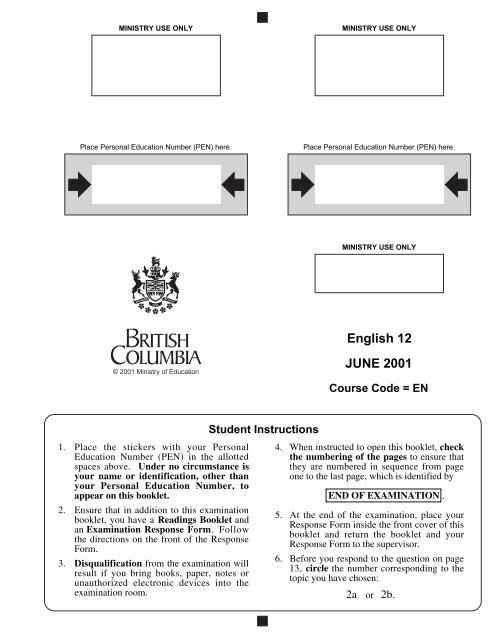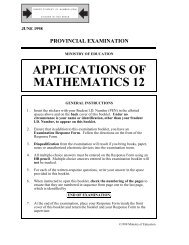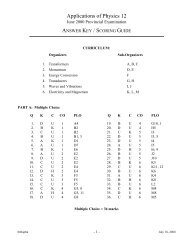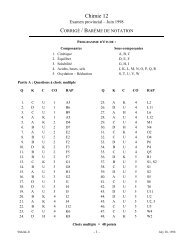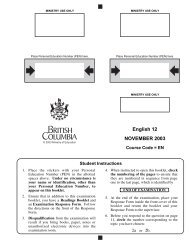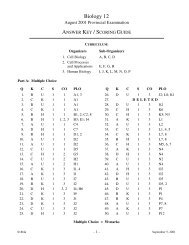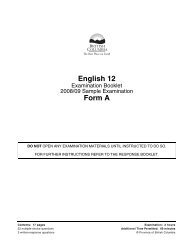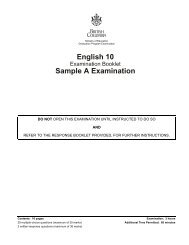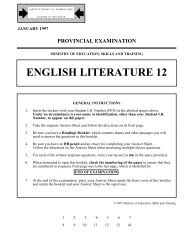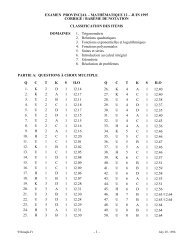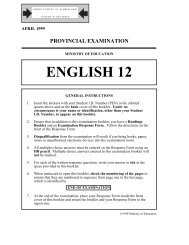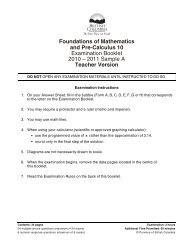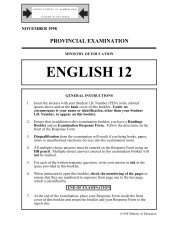English 12 JUNE 2001 - QuestionBank.CA
English 12 JUNE 2001 - QuestionBank.CA
English 12 JUNE 2001 - QuestionBank.CA
Create successful ePaper yourself
Turn your PDF publications into a flip-book with our unique Google optimized e-Paper software.
MINISTRY USE ONLY<br />
MINISTRY USE ONLY<br />
Place Personal Education Number (PEN) here.<br />
Place Personal Education Number (PEN) here.<br />
MINISTRY USE ONLY<br />
<strong>English</strong> <strong>12</strong><br />
© <strong>2001</strong> Ministry of Education<br />
<strong>JUNE</strong> <strong>2001</strong><br />
Course Code = EN<br />
Student Instructions<br />
1. Place the stickers with your Personal<br />
Education Number (PEN) in the allotted<br />
spaces above. Under no circumstance is<br />
your name or identification, other than<br />
your Personal Education Number, to<br />
appear on this booklet.<br />
2. Ensure that in addition to this examination<br />
booklet, you have a Readings Booklet and<br />
an Examination Response Form. Follow<br />
the directions on the front of the Response<br />
Form.<br />
3. Disqualification from the examination will<br />
result if you bring books, paper, notes or<br />
unauthorized electronic devices into the<br />
examination room.<br />
4. When instructed to open this booklet, check<br />
the numbering of the pages to ensure that<br />
they are numbered in sequence from page<br />
one to the last page, which is identified by<br />
END OF EXAMINATION .<br />
5. At the end of the examination, place your<br />
Response Form inside the front cover of this<br />
booklet and return the booklet and your<br />
Response Form to the supervisor.<br />
6. Before you respond to the question on page<br />
13, circle the number corresponding to the<br />
topic you have chosen:<br />
2a or 2b.
Question 1:<br />
1. .<br />
(<strong>12</strong>)<br />
Question 2a:<br />
2a. .<br />
(24)<br />
Question 2b:<br />
2b. .<br />
(24)<br />
⎫<br />
⎪<br />
⎪<br />
⎪<br />
⎪<br />
⎪<br />
⎬ Score only<br />
⎪ one of the two<br />
⎪ questions given.<br />
⎪<br />
⎪<br />
⎪<br />
⎭⎪<br />
Question 3:<br />
3. .<br />
(24)
ENGLISH <strong>12</strong><br />
<strong>JUNE</strong> <strong>2001</strong><br />
COURSE CODE = EN
GENERAL INSTRUCTIONS<br />
1. Electronic devices, including dictionaries and pagers, are not permitted in the<br />
examination room.<br />
2. All multiple-choice answers must be entered on the Response Form using an<br />
HB pencil. Multiple-choice answers entered in this examination booklet will not<br />
be marked.<br />
3. For each of the written-response questions, write your answer in ink in the space<br />
provided in this booklet.<br />
Adequate writing space has been provided for average-sized writing. Do not<br />
attempt to determine the length of your answers by the amount of writing space<br />
available. You may not need to use all the allotted space for your answers.<br />
4. Ensure that you use language and content appropriate to the purpose and audience<br />
of this examination. Failure to comply may result in your paper being awarded a<br />
zero.<br />
5. This examination is designed to be completed in two hours. Students may,<br />
however, take up to 30 minutes of additional time to finish.
ENGLISH <strong>12</strong> PROVINCIAL EXAMINATION<br />
1. This examination consists of four parts:<br />
Value<br />
Suggested<br />
Time<br />
PART A: Editing, Proofreading and<br />
Comprehension Skills<br />
13 10<br />
PART B: Interpretation of Literature: Poetry 20 25<br />
PART C: Interpretation of Literature: Prose 33 45<br />
PART D: Original Composition 24 40<br />
Total: 90 marks <strong>12</strong>0 minutes<br />
2. The Readings Booklet contains the prose and poetry passages you will need to<br />
answer certain questions on this examination.<br />
- 1 -<br />
OVER
PART A: EDITING, PROOFREADING AND COMPREHENSION SKILLS<br />
Total Value: 13 marks<br />
Suggested Time: 10 minutes<br />
INSTRUCTIONS:<br />
The following passage has been divided into numbered sentences which may<br />
contain problems in grammar, usage, word choice, spelling, or punctuation. One or<br />
more sentences may be correct. No sentence contains more than one error.<br />
If you find an error, select the underlined part that must be changed in order to make<br />
the sentence correct and record your choice on the Response Form provided. Using<br />
an HB pencil, completely fill in the circle that corresponds to your answer. If there<br />
is no error, completely fill in circle D (no error).<br />
GLASSMAKING<br />
1. This year, a central part of Jerusalem’s annual celebration will be a massive<br />
(A)<br />
exhibition of glass sculpture’s honouring the region’s history of glassmaking.<br />
(B)<br />
(C)<br />
(D) no error<br />
2. The exhibit will feature over four thousand glass pieces shaped<br />
(A)<br />
into fifteen sculptures. One of which is an impressive waterfall<br />
(B)<br />
(C)<br />
of glass.<br />
(D) no error<br />
3. Although we may never know<br />
(A)<br />
Syrian / Israeli region may be traced to ancient times.<br />
(C)<br />
the actual source of glassmaking, their origins in the<br />
(B)<br />
(D) no error<br />
4. An early story by Roman historian August Callus was telling of glass that formed<br />
(A)<br />
(B)<br />
under cooking pots when soldiers heated their meals over fires set in sandy soils.<br />
(C)<br />
(D) no error<br />
5. Glass, then, may have appeared first<br />
(A)<br />
processes such as smelting copper<br />
(B)<br />
involved extremely high temperatures.<br />
as the unwanted byproduct of this activity and other<br />
or firing ceramics; because these procedures<br />
(C)<br />
(D) no error<br />
- 2 -
6. “The first true artifacts, according to Kim Motohashi, art historian, “were beads<br />
(A)<br />
(B)<br />
from Mesopotamia, an area which remained for centuries the heart of the<br />
(C)<br />
glassmaking craft.”<br />
(D) no error<br />
7. Until 50 BC, the painstaking nature of glassmaking involved<br />
(A)<br />
forming a mold, applying molten glass to it, and then cut the glass<br />
(B)<br />
(C)<br />
from the mold.<br />
(D) no error<br />
8. Consequently, very few glass containers<br />
(A)<br />
were considered a valuable luxury item, obtainable<br />
(C)<br />
were produced; those who were made ,<br />
(B)<br />
only by the rich.<br />
(D) no error<br />
9. This fact would account for the great secrecy attached to this<br />
(A)<br />
profession, ancient artisans were not allowed to have visitors at their place of work,<br />
(B)<br />
and many were not permitted to travel.<br />
(C)<br />
(D) no error<br />
10. Nowadays, glass is not only<br />
(A)<br />
medium, but also a highly<br />
(B)<br />
a popular, mass-produced storage<br />
ornamented and creative form of artistic expression.<br />
(C)<br />
(D) no error<br />
- 3 -<br />
OVER
THIS PAGE INTENTIONALLY BLANK<br />
- 4 -
INSTRUCTIONS:<br />
Based on the information contained in the passage on pages 2 and 3, “Glassmaking”,<br />
select the best answer for questions 11 to 13 and record your choice on the Response<br />
Form provided.<br />
11. Sentence 4 indicates that early forms of glass were produced<br />
A. by accident.<br />
B. from copper.<br />
C. by historians.<br />
D. by cooking it.<br />
<strong>12</strong>. According to sentences 5 and 6, the first true artifacts were<br />
A. glass beads.<br />
B. fired ceramics.<br />
C. smelted copper.<br />
D. chemical byproducts.<br />
13. According to sentences 8 and 9, most ancient artisans<br />
A. were not allowed to travel.<br />
B. were allowed many visitors.<br />
C. produced inexpensive items.<br />
D. produced many glass containers.<br />
- 5 -<br />
OVER
Total Value: 20 marks<br />
PART B: POETRY<br />
Suggested Time: 25 minutes<br />
INSTRUCTIONS:<br />
Read the poem “Dearest Margaret” on page 1 in the Readings Booklet. Select the<br />
best answer for each question and record your choice on the Response Form<br />
provided.<br />
14. Line 1, “Yes; we’ve agreed, when we grow newly old”, contains an example of<br />
A. hyperbole.<br />
B. oxymoron.<br />
C. metonymy.<br />
D. understatement.<br />
15. In line 5, “and bleating of love,” the sound device used is<br />
A. alliteration.<br />
B. dissonance.<br />
C. onomatopoeia.<br />
D. internal rhyme.<br />
16. Lines 18 to 20, “Indeed, we can travel / wherever we like / as long as we’re home by noon”,<br />
suggest that the friends will<br />
A. travel extensively.<br />
B. have too many animals.<br />
C. be dedicated to the farm.<br />
D. need help looking after the farm.<br />
17. In line 30, the speaker jokingly comments, “(We’ll write them ourselves!)”, to indicate that<br />
A. their lives will be lonely.<br />
B. they are content to live alone.<br />
C. the mailman cannot locate them.<br />
D. they will become professional writers.<br />
18. Line 33, “unravel the prose of James Joyce”, suggests that the prose of James Joyce is<br />
A. boring.<br />
B. foreign.<br />
C. exciting.<br />
D. complex.<br />
- 6 -
19. In the poem, parentheses are used to enclose<br />
A. contradictions.<br />
B. inconsistencies.<br />
C. personal asides.<br />
D. random thoughts.<br />
20. The form of this poem is<br />
A. sonnet.<br />
B. free verse.<br />
C. blank verse.<br />
D. ballad stanza.<br />
21. The point of view of this poem is<br />
A. objective.<br />
B. omniscient.<br />
C. first person.<br />
D. limited omniscient.<br />
- 7 -<br />
OVER
Dearest Margaret<br />
(page 1 in the Readings Booklet)<br />
INSTRUCTIONS:<br />
In paragraph form and in approximately <strong>12</strong>5 to 150 words, answer question 1 in the<br />
space provided. Write in ink. The mark for your answer will be based on the<br />
appropriateness of the example(s) you use as well as the adequacy of your<br />
explanation and the quality of your written expression.<br />
1. The poem expresses the speaker’s idea of a perfect lifestyle. In paragraph form and with<br />
reference to the poem, discuss the qualities of this lifestyle.<br />
(<strong>12</strong> marks)<br />
- 8 -
Organization and Planning<br />
1st<br />
TOTAL<br />
2nd<br />
- 9 -<br />
OVER
Total Value: 33 marks<br />
PART C: PROSE<br />
Suggested Time: 45 minutes<br />
INSTRUCTIONS:<br />
Read the selection entitled “The Technology of Simplicity” on pages 2 and 3 in the<br />
Readings Booklet. Select the best answer for each question and record your choice<br />
on the Response Form provided.<br />
22. In paragraph 2, other hunters improve the narrator’s chances of seeing deer because they<br />
A. talk out loud.<br />
B. simply sit still.<br />
C. never scan the bush.<br />
D. keep the deer moving.<br />
23. In paragraph 2, the word “enigmatic” means<br />
A. silent.<br />
B. puzzling.<br />
C. enormous.<br />
D. imaginary.<br />
24. In paragraph 3, the narrator overcomes his boredom and impatience by<br />
A. having a nap.<br />
B. being elusive.<br />
C. being focussed.<br />
D. remaining silent.<br />
25. In paragraph 4, the dominant figure of speech used to describe the forest is<br />
A. simile.<br />
B. apostrophe.<br />
C. synecdoche.<br />
D. personification.<br />
26. In paragraph 4, the sentence, “I began to resent the occasional noisy intrusions of other hunters”<br />
could be considered<br />
A. rude.<br />
B. ironic.<br />
C. childish.<br />
D. sarcastic.<br />
- 10 -
27. In paragraph 5, the lesson about life the narrator learns is that<br />
A. technology helps humans.<br />
B. hunters know much about wildlife.<br />
C. people benefit from consumer culture.<br />
D. people benefit from shared experiences.<br />
28. In paragraph 6, the words “materialistic”, “consumptive”, and “throughput” are put in<br />
quotations to show<br />
A. slang.<br />
B. dialogue.<br />
C. emphasis.<br />
D. repetition.<br />
29. In paragraph 6, the narrator indicates that our current society is<br />
A. caring.<br />
B. attentive.<br />
C. materialistic.<br />
D. unappreciative.<br />
30. This passage is a<br />
A. biography.<br />
B. modern fable.<br />
C. personal essay.<br />
D. technical treatise.<br />
- 11 -<br />
OVER
Organization and Planning<br />
- <strong>12</strong> -
The Technology of Simplicity<br />
(pages 2 and 3 in the Readings Booklet)<br />
INSTRUCTIONS:<br />
Choose one of the following two topics and write a multi-paragraph essay of<br />
approximately 300 words. Write in ink. The mark for your answer will be based<br />
on the appropriateness of the example(s) you use as well as the adequacy of your<br />
explanation and the quality of your written expression.<br />
2a. In multi-paragraph essay form and with reference to the selection, discuss the element of<br />
contrast in the story.<br />
OR<br />
2b. In multi-paragraph essay form and with reference to the selection, discuss the lessons about life<br />
that the narrator has learned.<br />
Before you begin, go to the front cover of this booklet and circle<br />
the number corresponding to your chosen topic – Instruction 6.<br />
(24 marks)<br />
I have selected topic _______.<br />
FINISHED WORK<br />
- 13 -<br />
OVER
FINISHED WORK<br />
- 14 -
FINISHED WORK<br />
1st<br />
SUBTOTAL<br />
2nd<br />
- 15 -<br />
OVER
Organization and Planning<br />
- 16 -
Value: 24 marks<br />
PART D: ORIGINAL COMPOSITION<br />
Suggested Time: 40 minutes<br />
INSTRUCTIONS:<br />
Using standard <strong>English</strong>, write a coherent, unified, multi-paragraph composition of<br />
approximately 300 words on the topic below. In your composition, you may apply<br />
any effective and appropriate method of development which includes any<br />
combination of exposition, persuasion, description, and narration.<br />
Use the page headed Organization and Planning for your rough work. Write your<br />
composition in ink on the pages headed Finished Work.<br />
3. Write a multi-paragraph composition on the topic below. In addressing the topic, you may<br />
draw support from the pictures below, the experiences of others, or from any aspect of your<br />
life: your reading, your own experiences, and so on.<br />
Topic:<br />
A good life does not have to be complex.<br />
- 17 -<br />
OVER
FINISHED WORK<br />
Topic: A good life does not have to be complex.<br />
- 18 -
FINISHED WORK<br />
- 19 -<br />
OVER
FINISHED WORK<br />
END OF EXAMINATION<br />
1st<br />
SUBTOTAL<br />
2nd<br />
- 20 -
ENGLISH <strong>12</strong><br />
READINGS BOOKLET<br />
<strong>JUNE</strong> <strong>2001</strong><br />
©<strong>2001</strong> Ministry of Education
THIS PAGE INTENTIONALLY BLANK
PART B: POETRY<br />
INSTRUCTIONS:<br />
Read the following passage and answer the questions on pages 6 to 9 of the<br />
written-response booklet.<br />
Dearest Margaret<br />
by Eleanor Byers<br />
1<br />
5<br />
10<br />
15<br />
20<br />
25<br />
30<br />
Yes; we’ve agreed, when we grow newly old<br />
to live side by side on your farm in Vermont<br />
where we can raise goats<br />
the small brown kind, following close<br />
and bleating of love.<br />
We’ve said we want cats, all colours of cats<br />
to play in the shade on hot summer days,<br />
to purr by the stove when evenings are cold.<br />
And, Margaret, remember our plan to grow plants<br />
with long Latin names<br />
and prizewinning Bibb lettuce<br />
for good-tasting salads.<br />
You’ll make tabbouleh (you do it so well).<br />
I’ll roast a capon (with shallots and beans).<br />
How well we will dine<br />
drinking mint tea or watered white wine<br />
followed by cheese and sweet almonds.<br />
Indeed, we can travel<br />
wherever we like<br />
as long as we’re home by noon<br />
to pet the cats, feed the goats,<br />
water the prizewinning lettuce.<br />
When winter snow falls<br />
we will pull on tall boots and warm, woolly coats<br />
and slosh down our paths to the tin mailbox<br />
by the side of the road.<br />
To the postman we’ll offer our best apple tart<br />
hot from the oven, with cream<br />
in exchange for choice letters.<br />
(We’ll write them ourselves!)<br />
Oh, Margaret, let’s read Ulysses<br />
(again) and this time, patient with age,<br />
unravel the prose of James Joyce.<br />
- 1 -<br />
OVER
PART C: PROSE<br />
INSTRUCTIONS:<br />
Read the following selection and answer the questions on pages 10 to 15 of the<br />
written-response booklet.<br />
The Technology of Simplicity<br />
by Mark A. Burch<br />
1 When I was eleven or twelve, I used to go deer hunting with my father. He would wake me before<br />
dawn on cold, crisp October days, and we would dress silently in the dim glow of a night light, not<br />
wanting to awaken the rest of the house. He would already have packed his hunting gear in the car.<br />
It was always still dark when we made our way into the woods along paths it seemed only my father<br />
knew, until we found the blind we had built days before, overlooking pathways frequented by whitetailed<br />
deer.<br />
2 This technique was called “still hunting”: one simply sat silently, motionless and endlessly patient,<br />
waiting for deer to come down the paths. There was always an abundance of less patient hunters in<br />
the woods, noisily crashing about, keeping the deer more or less constantly on the move during<br />
hunting season. Once in the blind, we would sit utterly still, our only movements being our<br />
breathing and the slow turning of our heads this way and that as we scanned the bush for those<br />
enigmatic forms that seemed to appear almost magically out of nowhere. We would sit this way for<br />
hours.<br />
3 One might think such activity would be boring. But my father taught me to overcome my boredom<br />
and impatience—the discomfort of sitting, the disappointment of not seeing a deer—through the<br />
practice of continually renewed vigilance. Deer themselves were so elusive, so silent and well<br />
camouflaged, that at any time one might “appear” that previously had been invisible, although there<br />
all along. The possibility of finding a hidden deer created such motivation for me that moments of<br />
inattention or boredom were quickly dispelled by the renewed effort to discern the indiscernible.<br />
Every once in a while, this effort would succeed, which was reward enough to make me try even<br />
harder the next time to stay still, silent, and attentive. Twenty-five years later, I would realize that<br />
what my father was teaching me, though he didn’t know it himself, was not hunting but meditation—<br />
or, more accurately, hunting as a pathway into meditation.<br />
4 As my capacity for sitting still became more fully developed, I found I could spend whole mornings<br />
in the bush, from false dawn to noon, my senses riveted on the changing patterns of light, colour,<br />
form, and sound in the forest. I learned to hear things wake up. I learned to see the forest playing,<br />
feeding, breathing. I sensed how the whole forest was a community that could observe me. If I was<br />
silent enough, it seemed to forget me, or perhaps accept me as part of itself, and then go about its<br />
business: birds called, chipmunks played in the leaves, squirrels gathered hazelnuts, chickadees<br />
performed their bizarre acrobatic stunts while searching for insect larvae. In all of this, I began to<br />
feel less like a hunter invading the bush to get something from it, and more like a part of the forest<br />
itself. I started to feel at home. I began to resent the occasional noisy intrusions of other hunters. At<br />
times, I felt a contentment so deep that it seemed I was absorbed in a timeless dream, dreaming the<br />
forest’s dream of itself. As this capacity developed in me, I ceased to care whether or not I saw deer,<br />
and largely lost my desire to kill one. It was enough just to be in the bush, to be with the bush. It<br />
also became entirely irrelevant how I was dressed (other than being protected from the elements) and<br />
whether or not I had a weapon. Eventually, I started to look on my bow and arrows, my hunting<br />
- 2 -
camouflage and boots, not as hunting gear for killing game, but as camouflage gear to hide me from<br />
other hunters. They would all think I was out there to get my buck! They would all think I was one<br />
of them. But in fact I only appeared to be one of them. Little did they know that, once I was in the<br />
forest, my main goal was just to sit!<br />
5 This transformation from a fidgety twelve-year-old to a contemplative adolescent is an example of<br />
the applied technology of simplicity. No thing was required for this rich development of my<br />
capacities to see, hear, and feel the forest. Hunting was the occasion, a rationale both my father and I<br />
believed in, for something much more important to be taught and learned. I would not have needed<br />
to be hunting to learn this; in fact, I didn’t need any thing that the consumer culture could provide.<br />
What was necessary was the example of my father’s wisdom, his love of the outdoors, and his<br />
patience and generous sharing of this experience with me.<br />
6 I am careful not to call North American society “materialistic,” but rather “consumptive.” We have<br />
engineered a way of life that equates satisfaction with “throughput,” an awkward but descriptive term<br />
that refers to the rate and quantity of things used up, rather than the depth or intensity of experience.<br />
A truly materialistic society would love material things and promote their conservation and<br />
enjoyment. But a consumptive society is neither materialistic nor spiritual. It enjoys less and less as<br />
it tries to consume more and more. The very rate at which consumption proceeds virtually negates<br />
the possibility of attentiveness and mindfulness. We don’t pay attention to the sources of the things<br />
we use, or to the effects of making and harvesting them, or to the experience of using and enjoying<br />
them, or to the consequences of having used them. Despite promises to the contrary, the<br />
consumptive society produces stupor and waste, rather than pleasure and well-made material<br />
artifacts.<br />
7 When my children were experiencing their first few Christmas holidays, I saw a very clear example<br />
of how we teach ourselves to forsake mindfulness for consumptiveness. Emerging from their beds<br />
on Christmas morning, they found the traditional tree with piles of presents underneath. Being the<br />
only grandchildren in the family at the time, they made quite an enormous haul. Each was handed a<br />
present and taught how to open it, a skill that right away required them to forgo their obvious delight<br />
with the wrapping paper, the soft ribbons, the dangling decorations affixed to the packages.<br />
Discovering their first toys of the day, both children settled down to play, thoroughly exploring the<br />
possibilities of these new objects. This would have taken all morning, as it should, if not for the<br />
adult relatives, whose joy in the season had come to mean experiencing abundance as quantity, rather<br />
than as richness. The object of this Christmas-morning exercise was to open presents, not to<br />
experience them. It was necessary to get on with the next thing, to stay in motion, to consume. So<br />
(not without smiles or gentleness) one present after another was removed to be replaced by an<br />
unopened package. I remember the expression of bewilderment on my son’s face as he was trying to<br />
understand the meaning of this behaviour. Being a child, he learned very quickly. By late morning,<br />
opening presents had turned into a pandemonium of ripping paper. By lunch time, all the presents<br />
were open, the new toys were scattered in various corners of the family room, and my children were<br />
off playing with the empty boxes. They had learned well: life in the consumer society is the<br />
moment of newness, the adrenaline rush of discovery, the hypercharged, narcotic-like flash of<br />
novelty that goes with “throughput.” Thou shalt not pay attention. Thou shalt not linger. Thou shalt<br />
not enjoy. Thou shalt keep moving.<br />
8 I do not mean to disparage the generous intentions of my family—only to point out a self-defeating<br />
illusion to which we are all prone. The real poverty of our generation is that we don’t know how to<br />
savour as well as we know how to consume.<br />
- 3 -
ACKNOWLEDGEMENTS<br />
Burch, Mark A. “The Technology of Simplicity”. Excerpted from Simplicity:<br />
Notes, Stories and Exercises for Developing Unimaginable Wealth. © 1995 by<br />
Mark A. Burch.<br />
Byers, Eleanor. “Dearest Margaret”. If I Had My Life to Live Over, I Would Pick<br />
More Daisies. Ed. Sandra Martz. Watsonville, California: Papier-Mache Press,<br />
1992.<br />
- 4 -


